Handicraft Works in Vietnam
From North to the South of Vietnam, you can find handicraft works everywhere. The range of Handicraft include lacquer ware, silver, ceramics and many more. Although there are more of these places in the North from Hanoi to Hue, it is the easiest to buy these products in Ho Chi Minh city or the Captial of Vietnam, Hanoi.
1. Ha Thai Lacquer-ware Village Address: Ha Thai village, Duyen Thai commune, Thuong Tin district, Hanoi.
Products: Lacquer painting products Ha Thai village – Duyen Thai commune is located right by side of 1A national highway and among other famous trade villages. Ha Thai village’s lacquer painting itself has developed for a long time. Previously, the village had one largest lacquer painting cooperative in the former Ha Son Binh province with 500 households joined in the cooperative. After that, exporting lacquer painting product was slow downed by fluctuations of East European markets. However, for the past years, thank to the State’s new mechanism and opening policies, Ha Thai’s lacquer painting industry has been strongly developing. A number of the former cooperative members become managers of large-scaled enterprises with annual revenue of billions VND. Ha Thai’s products are so diverse with thousands of different designs and models satisfying demands of many international markets. 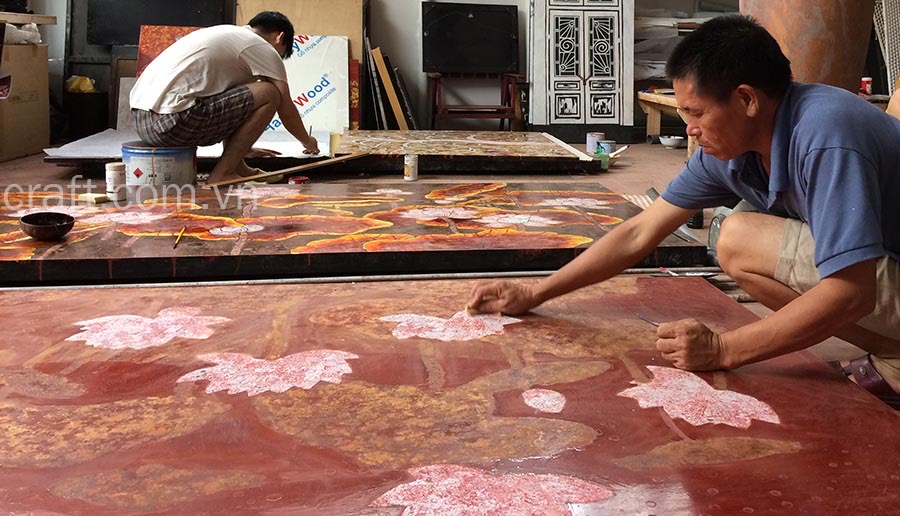
2. Dinh Cong Jewelry Village Address: Dinh Cong Precinct, Hoang Mai district, Hanoi
Products: Silver jewelry “My village is full of jewelers/ May I make you a little ring?” The verse reminds us of Dinh Cong Jewelry Village near Hanoi, which once sipplied jewelry to the royal court of Thang Long Citadel. On every Lunar December 2. Jewelers in Dinh Cong Village assemble in the communal house to pray to the founders of ther craft. According to legend, during the Ly dynasty there were three brothers named Tran Hoa, Tran Dien and Tran Dien who settled in Dinh Cong Village. They were accomplished jewelers who passed their skills to their neighbors. Examining the tiny details on a sliver plate or box we can’t help but admire the creativity of the village’s artisans. Their hard work and attention to detail have broughr fame to this little village and its precious silver products.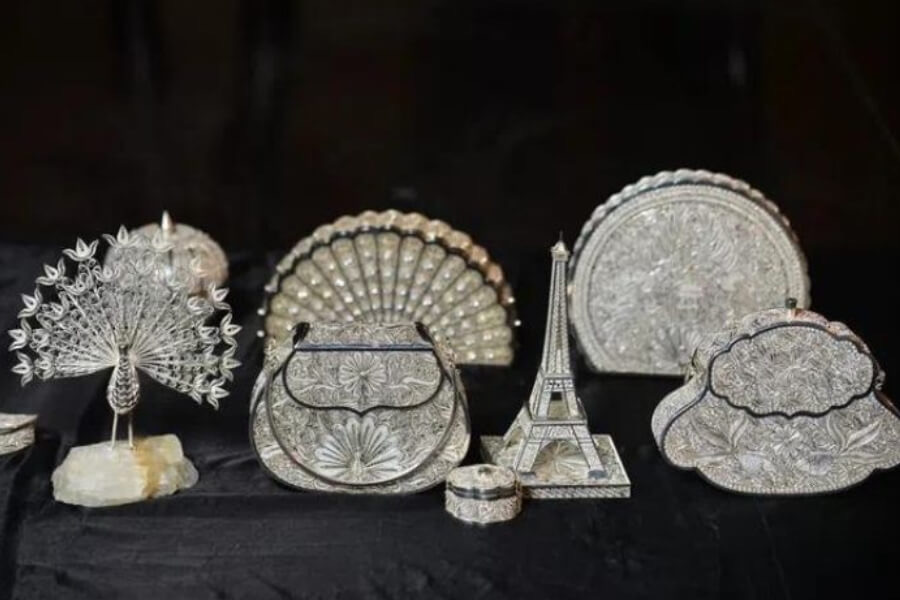
3. Bat Trang Porcelain Village Address: Bat Trang Porcelain village, Bat Trang Commune, Gia Lam District, Hanoi.
Products: Ceramic and Pottery products Bat Trang, a small village in the north of Vietnam, is about 13 kilometers south east of Hanoi center, on the other side of Chuong Duong bridge. Why is its name popular to most tourists to northern Vietnam? The answer is its ever famous ceramic and pottery products of high quality. If you have known about Vietnam, you may not be surprised that Bat Trang’s vases, bowls, dishes, and many other kinds of ceramic products have been exported worldwide. Should you would like to contemplate workers making ceramic products by hand, just come here! What’s more, you can also try it yourself!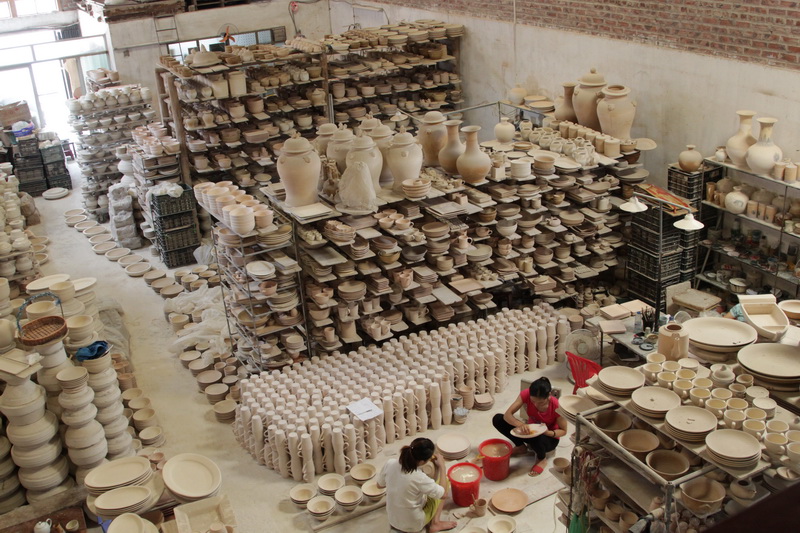
4. Dong Ho Painting Village Address: Dong Ho Village, Song Ho Commune, Thuan Thanh District, Bac Ninh.
Products: Handmade prints made using old woodblocks “My dear green-girdled maiden – Will you return to Mai Village with me? A place known for its rich traditions – Its tranquil river and printmaking heritage as well”. This old verse reminds people of Dong Ho, a famous printmaking village beside the Duong River. Visitors will find winding alleys, rustic brick houses, paddy fields, rows of banana trees and courtyards full of inky prints. Dong Ho Painting Village was founded in the 16th century. For more than 500 years, villagers have produced prints used for religious purpose and to greet the Lunar New Year. Villagers use wood-blocks to print pictures onto “do” paper, a special handmade type of paper made from “do” bark that has been brushed with ground clam sheels to lend it a sparkling shine. The prints typically feature scenes from folk tales or images designed to invite good luck, such as pigs with may off-spring. Printed in four bright colors, these simple images reflect Vietnam’s agrarian soul.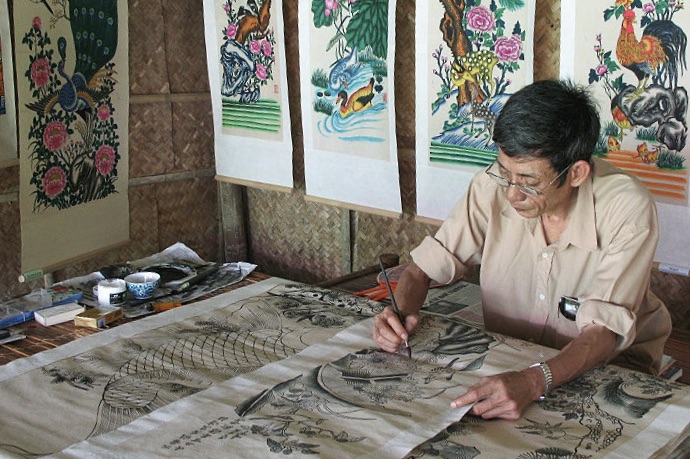
5. Van Phuc Silk Village Address: Van Phuc village, Ha Dong, Ha Noi
Products: shirts, ties, craft, dresses and many other things made of silk Located on the bank of Nhue River, 10km from southwest of Hanoi Old Quarter, Van Phuc village is renowned for its traditional weaving and premium quality silk products. At the age of over 1,200 years, Van Phuc is proud to be the most ancient silk village which provides the best silk in Vietnam. The village has been much well known for its traditional sericulture, weaving, and silk products. Tourists coming here are lured by various beautiful shirts, crafts, ties, dresses and many other things made of silk available in the village. What is special is that the silk is made by very simple looms, which is the genuinely traditional Vietnamese way of making silk.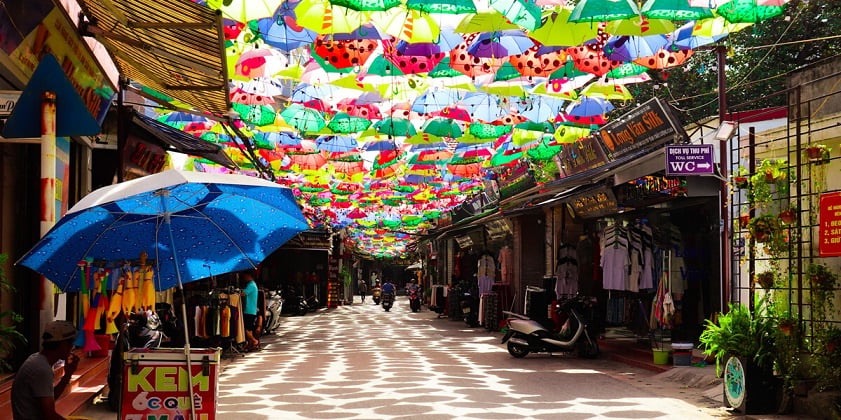
6. Quat Dong Embroidery Village Address: Quat Dong Village, Quat Dong commune, Thuong Tin district, Hanoi
Products: Embroidered products Whenever talking about Vietnamese traditional embroidery, people often mention to Quat Dong - ancestor of the embroidery with all the respect and pride. With the traditional over 400 years, many generations have followed the father's footsteps and brought the Vietnamese traditional embroidery to top of the art. There have many artists was born and grew up in this land, many names have became the pride of the Vietnamese traditional embroidery. For many Quat Dong villagers, embroidery is all of their life. Anyone when have an opportunity to arrived here also recognize the passion of the people is very honest and simple at here. Perhaps by that passion, soul artists have been formed and make the hands of all artisans here become magical.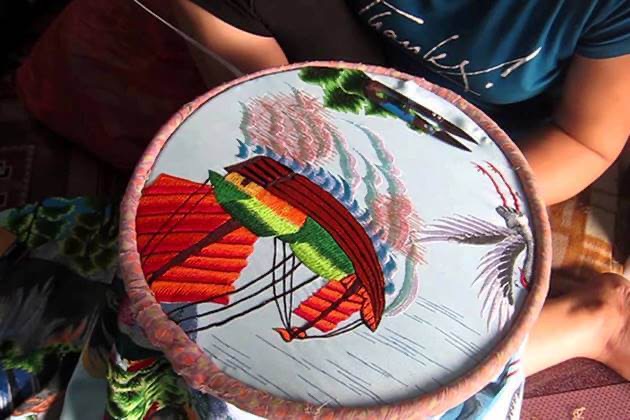
7. Cao Incense Hamlet Address: Cao Village, Bao Khe, Hung Yen.
Products: All varieties of incense Many villages in Northern Vietnam specialize in making incense, however, the most famous in Cao Hamlet, which is popularly known as “Incense Hamlet”. Located in Bao Khe Commune, Hung Yen Town, the village’s lanes and courtyards are draped with red and gold drying incense. Around the village, after the harvest, the exposed paddy fields stretch to the horizon. Cao Hamlet makes many types of incense, including compressed incense, helix incense, pole incense, and cinnamon incense. Each family uses a unique recipe of herbs to produce different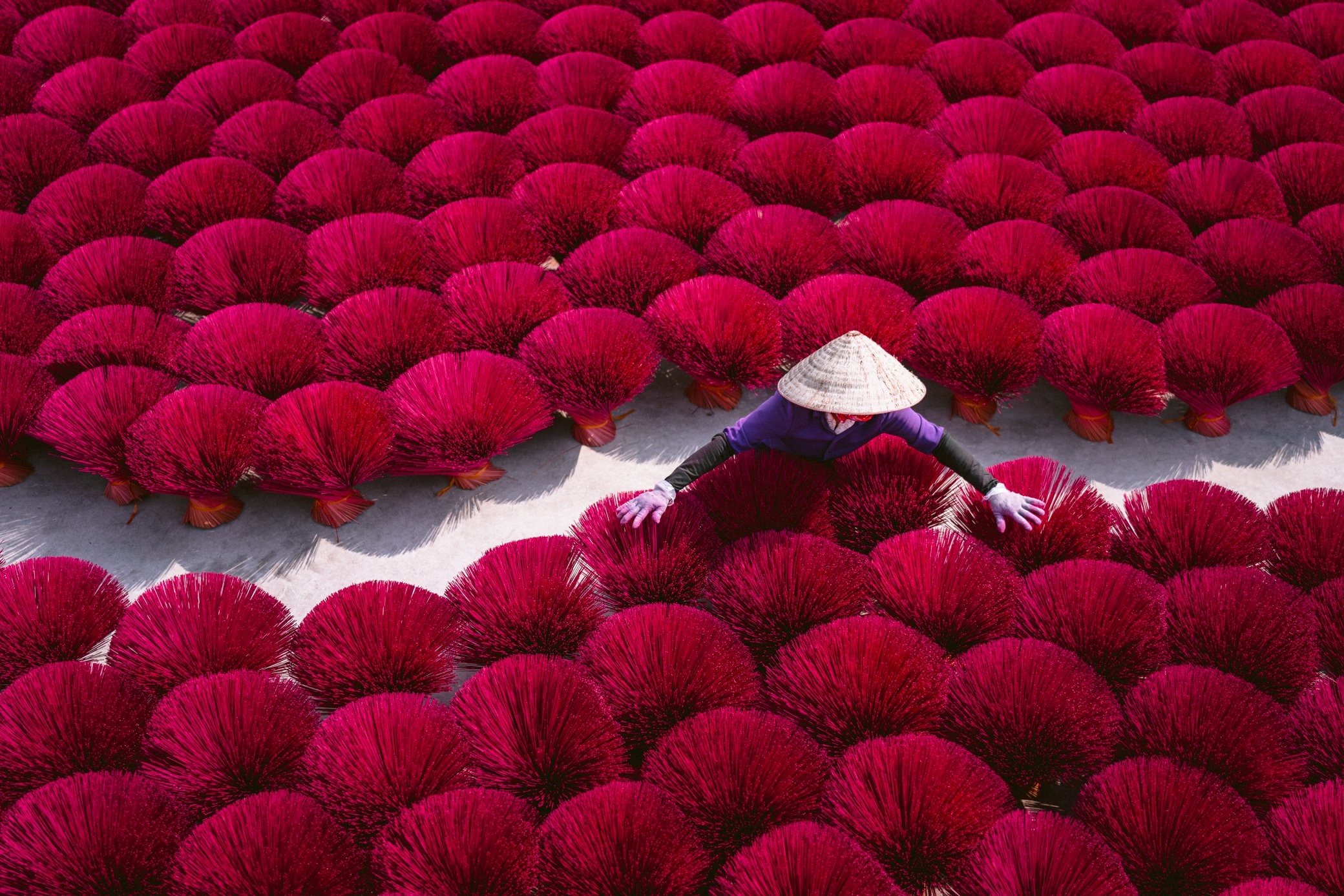
8. Van Giap Votives Village Address: Van Giap Village, Thuong Tin distric, Hanoi
Products: Votives made of paper and bamboos In run-up to Tet holidays, people in Van Giap votives village in Duyen Truong Commune, Phuc Am (Thuong Tin, Hanoi) are all busy sharpening bamboos, making frames, sticking paper and mixing glue. In the Oriental conception of “yin-yang life asymmetry”, Tet holidays would never be without some votives dedicated on altars to ancestors and the departed. To make finished votives, artisans have to complete many elaborate and complex stages. Finished frames are further processed to reinforce their durability. Next steps such as covering paper, cladding for puppets and decorations require huge patience and skills to make finished goods lifelike. Based on experiences passed on between generations that are combined with creativity and skillfulness, lives of Van Giap villagers have been markedly improved.
9. Son Dong Religious items Village Address: Son Dong Village, Hoai Duc district, Hanoi
Products: Handmade carved religious kits Lying about 15km from Hanoi center, Son Dong traditional craft village (Hoai Duc, Hanoi) is known for its well-preserved cultural essences in folk sculptures. Throughout so many turbulences in the national history, Son Dong craft village remains the firse choice for those who seek for paralleled sentences, bas-reliefs, Buddhist statues or religious items… Son Dong village was founded following the evolutions of Vietnamese Buddhism. Nowadays in Son Dong, every household has at least 1 person who is skillful at lacquering and sculpture. Main materials employed by villagers to make Buddhist statues or religious kits are usually jackfruit wood, “doi” wood and in particular golden cored wood, which is light and precious (its life span can reach 500 years in good conditions). These types of wood should meet some strict standards and rules to be used. As a result, product quality is always guaranteed and products’ life span is frequenntly longer than that of products of other locations. Thanks to diligence and good skills, Son Dong craft village has undergone a series of positive changes.
10. "To he" toy Village Address: Xuan La Village, Phuong Duc Commune, Phu Xuyen district, Hanoi.
Products: Toy figurines made of sticky rice paste Village has long been known for its “to he” toys, little figurines fashioned out of rice dough and stuck onto slender sticks of bamboo. Even today, villagers in Xuan lan continue this tradition, which is part of Vietnam’s national cultural identity. Made by hand, each rice dough figurine is a work of art. In the old days, children dream of “to he” toys made in the shapes of peasants, buffalos and national heroes such as the Trung Sisters, Lady Trieu, Le Loi or Quang Trung. Modern “to he” toys come in even more shapes, including cartoon characters and super heroes. The artisans create these little figurines out of brightly colored soft dough. “To he” toys are a source of pride, as modern childrn continue to delight in these traditional toys.
11. Vac Bird Cage Village Address: Vac Village, Thanh Oai district, Hanoi
Products: Bird Cages made of bamboo branches Lying 30km southwest of Hanoi center, Vac Village (a folk name of Canh Hoach Village, Thanh Oai, Hanoi) is famous for its traditional bird cage making traditions. Currently, Vac Village is home to about 100 cage making households. Thanks to rising demands for bird cages over the last 5 years, people’s living standards are on the rise. Villagers take great pride of their signature bird cages that won various medals in exhibitions in Hanoi during the French colonial era. Derived from old versatile fan making techniques, Vac artisans have created picturesque bird cages from their familiar sources of bamboos to satisfy bird collection pursuit on the rise. Skilful craft artisans of Vac village help breath life to fine bird cages consumed both domestically and internationally. Bird cages of the village have traveled all around the country, making them a ubiquitous cultural essence of the Vietnamese.
12. Tay Tuu Flower Village Address: Tay Tuu Village, Tu Liem district, Hanoi
Products: roses, daisies, lilies Follow the footsteps of Lady Dong Thi in the poem “An afternoon on West Lake” to Tay Tuu Village, long famous for its splendid flowers and uniquely Hanoi cultural beauty. In early Lunar October, the locals in Tay Tuu are busy preparing for the coming flower season. With thousands of fields of chrysanthemums, lilies and roses, etc., Tay Tuu Village resembles an outdoor flower museum. From afar, the flower fields resemble colorful carpets. As one of the oldest flower villages in Hanoi, Tay Tuu is a popular tourist destinations, especially in the days leading up to the Tet holidays.
13. Quang Ba Flower Village Address: Quang Ba Village, Nhat Tan, Tu Liem district, Hanoi
Products: daisies, dahlias, sunflowers, peaches and kumquat trees. In Lunar December, flower villages around Hanoi enter their peak season, as people buy potted plants to welcome the new spring. Quang Ba Flower Village has along been a source of pride for Hanoians. Generations of Hanoians have gone to Quang Ba, Nhat Tan and Tu Liem villages on the outskirts of the capital to buy colorful flowers for Tet. Nowadays, as land prices soar, less and less land is devoted to flower-growing. Plants still grown here inclide daisies, cry santhemums, dahlias and sunflowers. Long known for its flowering peach trees, Nhat Tan is now bare of flower fields. However as the New Year approaches, flower-growers from Quang Ba still sell flowering pink peach trees and orange-studded kumqat trees, along the dyke road beside the Red River.
14. Tan Quy Dong Flower Village Address: Tan Quy Dong Commune, Sa Dec Town, Dong Thap
Products: flowers and ornamentral plants, especially roses and bonsai In Southern Vietnam’s Dong Thap province, Sa Dec is famous for its flowers and bonsais. All year-round, Tan Quy Dong Flower Village is ablaze with colorful flowers grows here, including dahlias, hydrangeas, orchids, bottle-shaped arecas, Japanese cedar and French marigolds. The village’s most famous products, however, are its roses. Lying near a rich alluvial river, the village is also known for its ancient bonsai trees, some of which are hundreds of years old and very valuable. The village’s skilled bonsai masters have transformed common tree like star fruit trees, arecas and figs into works of art. Year-round, the village draws tourists. In the weeks leading up to the Lunar New Year, the scene is especially colorful and festive.
15. Thanh Khuc "Chung" cake Village Address: Thanh Khuc Village, Duyen Ha Commune, Thanh Tri district, Hanoi
Products: "Chung" cakes made of sticky rice, green beans, pork and minced pepper In the run-up to Tet, walk down narrow lanes and along dykes near the Red River and you will reach Thanh Khuc Village, which consists of two smaller hamlets: Dam and Van, better known as “Chung cake hamlets”. On verandas you will see heaps of “dong” leaves, bamboo string and giant cauldrons full of boiling “chung” cakes. Thanh Khuc cakes are known for their high quality, cleanliness and fine appearance. Popular year-round, vast quantities of “chung” cakes are sold during the Lunar New Year holidays.
16. Cu Da Vermicelli Village Address: Cu Da village, Cu Khe, Thanh Oai district, Hanoi
Products: handmade vermicelli of dong rice powder Just 20km from busy downtown Hanoi lies Cu Da Vermicelli Village, long known for its vermicelli noodles. Lying beside the calm Nhue River, Cu Da Village is a lovely old village with a long history of vermicelli-making. After being processed, dong rice flour is rolled into thin crepes that are steamed and dried on large bamboo boards, then cut into golden strands of vermicelli. Cu Da is proud of these old traditions, which have been passed down for generations. After a turbulent history, the village has retained its secret vermicelli recipe and established its brand name.
17. Thuan Hung Paper Cake Village Address: Thuan Hung Commune, Thot Not District, Cantho
Products: Paper cake – traditional cake which people use to wrap foods. Visit the craft village in the morning, visitors have a chance to witness the peaceful and beautiful scenery with thousands of paper cakes dried under sunlight along the river’s banks and dozens of smoking stoves in houses. Each Paper cake is a kind of traditional cake which people use to wrap foods. The cake looks easy to make but it requires many phases. Firstly, you husk rice into flour, stir it with water then steam it in a boiled water pot. The pot is covered by a fabric layer on the top and put in a clay stove. After steamed, the cakes will be dried on two-meter-long trellis mats made of coconut leaves, with two people often needed to perform this task. Tourist will be invited by locals to enjoy freshly-made cakes with soy sauce mixed with chili and fresh cucumber. Cakes come in many flavors including salty, soft, sprinkled with black sesame and coconut.
18. Tuyet Diem Salt Making Village Address: Tuyet Diem village, Xuan Binh Commune, Song Cau District, Phu Yen
Products: Salt Has been established since 1870, Tuyet Diem salt field is 143 years old now. Salt making career is much harder than farming. Every year, craftsmen work depending on only some sunny months of summer. The more blazing the sunshine is, the purer the salt is and… the saltier the sweat dropping on the makers’ bony shoulders is. Phu Yen salt making career has encountered many ups and downs. Despite of extremely hard working, the face toward the salty water, the back toward the sky, craftsmen still have tough life generation by generation.
19. Tan Chau Silk Village Address: Tan Chau village, Tan Chau district, An Giang province
Products: Lanh My A silk - Special satin silk Not only for legends and remains, Tan Chau silk village in An Giang is also famous for the brilliant past of a special craft village. Tan Chau silk has its fame because of the softness, toughness, long-wearing and high absorbability of natural silk material. All clothes made from Tan Chau silk bring to people comfort, coolness in summer, warmness in winter. Tan Chau silk is deserved to be called “Queen” of silk. Actually, materials for making Tan Chau silk are all produced by local people themselves. They grow shrubbery feeding silkworm to generate silk, plant mac nua (D. mollis) tree to take its fruit making dye. To make a unit of Tan Chau silk, the makers must spend many time and labor in many different parts of process.
20. Pottery Village in Vinh Long province Address: along Co Chien river, Long Ho district, Vinh Long province
Products: Pottery products Two kilometers from downtown after crossing Thieng Duc Bridge on National 31 along Co Chien River, in the distance, you will see heaving kilns with white smoke emitting into the sky. That is the kingdom of red ceramics. The famous pottery craft village which has been in operation for 20 years along the Co Chien River. Coming to the village, tourist will see the many phases involved in making ceramics. First, artisans have to dig out clay from under the river, load it off boats, classify and then mix it with sand. This is a very important process which will decide on the quality of the products. The mixed clay is then carefully kneaded, with the kneaded clay put into moulds and then into kilns. Finally, artisans have to whittle until the products are perfect.
21. Tuong Binh Hiep Lacquer-ware Village Address: Tuong Binh Hiep village, Thu Dau 1 district, Binh Duong province
Products: Lacquer products The traditional products of Tuong Binh Hiep are lacquer paintings which depict historic scenes. Making a lacquer painting is quite complicated process. The painter must follow a strict order in the application of color in each figure. For this reason a design must be well planned out beforehand. While the piece is kept wet and warm the painter must apply coat after coat in a specified manner. Without being able to distinguish the exact stroke shape or color intensity before polishing, the painters of Tuong Binh Hiep must rely heavily on their experience to master this craft. With their refined skills the artisans of Tuong Binh Hiep found little difficulty in adapting to the new market trends in recent years demanding professionally lacquered home appliances such as trays, boxes, cups and bowls. Their lacquer colors are so alluring and charming, customers from around the world have repeatedly made orders specifically requesting extensive color schemes.
22. Non Nuoc Stone Carving Village Address: Hoa Hai ward, Ngu Hanh Son district, Quang Nam province
Products: Varieties of Stone carving products Visiting the village of stone, you're not out of admiration before the artwork is made from stone, each show features works are talented, subtle of the craftsmen. Often there are all sorts of work shapes of things, most impressive was the Buddha statues, saints, God, Venus, mythical animals such as unicorns, dragons and stone lamps and stone jewelry... Air travelers will be on the air, working lifestyle of the village lively art. If preferred, guests can participate in a stage of processing as an artisan's village. Tourists come here are very interested in buying souvenirs made of stone gifts, products for small, lightweight, you can buy directly but for large, bulky items you can order in advance and all the sales base will have staff assigned to the address as required, including overseas.
23. Coconut Handicraft Villages Address: Chau Thanh district - Giong Tom district, Ben Tre province
Products: Varieties product of coconuts Making fine handicraft products is one of the characteristics of Ben Tre, because this place is the home land of coconut, which is used as the only materials for this kind of handicraft products. In the hands of the dexterous artists here, any single piece of coconut materials may turn into fine items with great charm and fantasy, such as animal statuettes, human face statuettes, etc. Coconut candy is another kind of Ben Tre specialty and a traditional product, which is sold both in domestic stores and exported to many countries around the world. Visitors can find these products mostly in Chau Thanh (Con Phung, Con Quy, An Hoa) and Giong Trom Districts.
24. Thanh Ha Pottery Village Address: 3 km West of Hoi An, Hoi An, Quang Nam province
Products: Pottery products In the 16th and 17th century Thanh Ha was a thriving village, It was famous for earthenware that was sold in many provinces throughout central Vietnam. It was Thanh Ha villagers who made the bricks, tiles and floor slabs for the old buildings in Hoi An and the surrounding areas. Thanh Ha craftmen now are continuing their ancestors’s work. With clever hands, they make the flower vases, tea pots, pig banks, big jars, or the decorative animals such as birds, tortoises, buffaloes, cats, ducks… Nowadays many old buildings in Hoi An need restoring and Thanh Ha villages are the only contractors that can provide standardized bricks, tiles and floor slabs exactly like the ones when the old port town prospered.
25. Lantern making Village Address: Hoi An Ancient town, Quang Nam province
Products: Many kinds of lantern products Hoi An lantern is various size and shape, from normal lantern to dragon lantern or fish lantern with full of color. Hoi An people highly pride on their lantern. It is very simple and easy to do only with hard-work. In past, there was no "night of ancient city". There are about 30 families working lantern in Hoi An. They have to use the old bamboo soaking ten-day in salt water against wormhole and moth then drying it and sharpening it as the size of lantern. Cloth must be silken or nylon cloth, enough toughs for stretching and stretching worker need good technique to do it. To be done a couple of lantern requires 4-work day and 3 decorative works. The recurrent night of ancient city, holidays, Tet holiday with multi- color lantern on very roads. It make everybody feel a happier and more lovely Hoi An.
26. Kim Bong Carpentry Village Address: Cam Kim commune, Hoi An, Quang Nam province
Products: Wood carving products Kim Bong Carpentry Village: Kim Bong village is well known for its carpentry. Most of Hoi An old town’s architecture was made by their ancestors. The craftmen from this village are very clever and talented through their wood carving products such as: sculpture columns of old houses, altars, tables and chairs, beds, wardrobes … Somes of craftmen are able to retain the traditional wood carving ways from their ancestors. Somes of them can build a boat for the fishermen in the center of Viet Nam. They also restore the old houses in the city, sculpt statues, making tables and chairs for export.
27. Tra Que Vegetable Village Address: 3 km North West of Hoi An, Hoi An, Quang Nam province
Products: Many kinds of vegetables: lettuce, salad, houttuynia ... Tra Que is a charming little village located just a few kilometres from Northeast of Hoi An. Its location is between De Vong river and Tra Que alga pond (Cam Ha commune - Hoi An town). This village is famous for many kinds of vegetables in a long time: lettuce, salad, houttuynia, flagrant knoutwed, basil and coriander vegetables etc., The village is named after the sweet scented vegetables that spice up the everyday meals of the Hoi An people. Here a new spirit for traditional Hoi An dishes like Cao Lau, Quang noodles, the local ‘Tam huu' spring roll (made from Tra Que vegetables) and cake with meat (Banh xeo) has been enlivened. The farmers use neither manure nor chemical fertilisers but a kind of algae found only in a lagoon in Tra Que. As a result, the vegetables both look beautiful in their fields as well as possessing outstanding taste and flavour. Products sell well and are highly appreciated due to the freshness, good quality and safety. Everyday all the year round, 8 tons of Tra Que vegetables are sold and people in Quang Nam-Danang area are addicted to having them in their meals. That is why many eaters, even the easiest ones said that they feel tasteless if their meals lack in Tra Que vegetables.
28. Phu Cam Conical Hat Village Address: Phu Cam Village (Phuoc Vinh Ward), south of An Cuu river bank, Hue.
Products: Conical hats Hue conical hat or Phu Cam conical hat has not only a beautiful form but also modest color. It is light and so thin that light seems to pierce through it. Through natural light, one can see Hue landscapes with verses engraved on paper placed between two layers of leaves. The conical hat form depends primarily on its frame, ensuring the technique of shaping the top, and of keeping equal distance between brims and roundness of brims. After the frame, comes the selection of hat leaves which should have a greenish white color. Leaves should be neither too young nor too old, only 8-9 are enough for making one hat. Following the choice of leaves is the process of drying and treatment. The Hue graceful conic hat has a frame of 16 big and small brims. Brims are curved into circumferences with the two ends skillfully tied by a small cotton thread. Handicraft workers carefully place and stitch greenish white leaves on the frame with a special thread made of transparent resistant silk. "Non Bai Tho" - Conical hat with inscribed verses - is an integral part of Hue culture. The production of hats in Hue is not only a handicraft but also an art which provides the society with artistic products.












